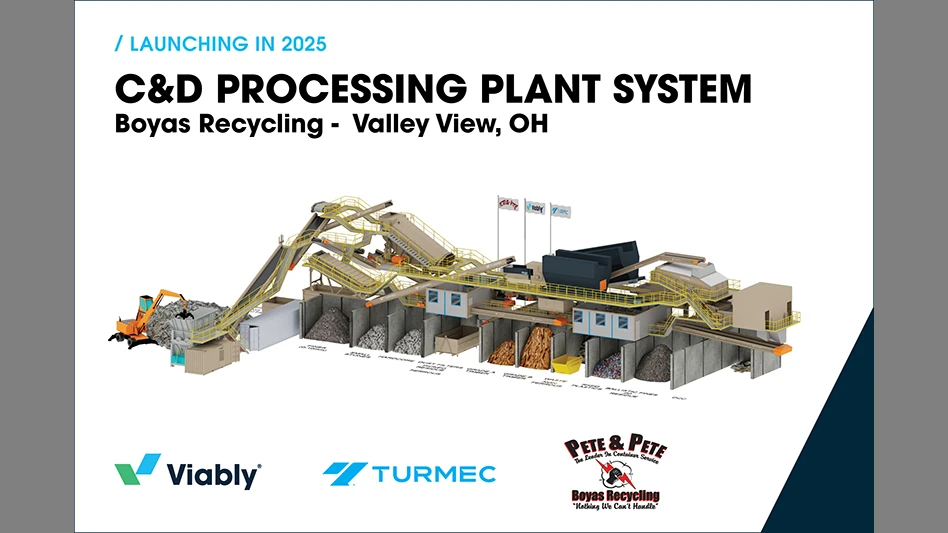
Material recovery facility (MRF) operators rely on screens to separate two-dimensional materials from three-dimensional materials. Over the years, these technologies have evolved to reduce costs and maintenance.
Traditional disc or star screens can separate materials efficiently but demand a high level of maintenance and upkeep. MRF operators with these traditional screens can spend extra time adjusting screen angles and speeds to prevent wrapping, but even after taking these preventive measures, materials can tangle, requiring downtime for cleaning and repair. Operators also need to regularly replace stars and discs that have become worn.
In the last six to eight years, new technologies have emerged that reduce screen maintenance. Operators designing new MRFs or upgrading existing facilities can opt for newer screening technologies, such as anti-wrapping screens, auger screens or ballistic separators (also referred to as elliptical screens).
“The role of traditional screens, in my opinion, has been minimized if used at all in today’s designs,” says Mark Henke, Midwest area manager of recycling at Phoenix-based Republic Services.
Changing material streams have proven challenging for older screens, as well. Henke says contamination has risen in many inbound material streams in the last few years, which can cause jams and increase the likelihood of unscheduled downtime at a MRF. Because material streams evolve, MRF operators will want to upgrade equipment with the future stream in mind.
Jeff Snyder, director of recycling at Cincinnati-based Rumpke Waste & Recycling, says his company is considering future material streams as it’s in the process of designing a new MRF in Columbus, Ohio. Rather than use traditional screens, he says, Rumpke plans to rely more heavily on trommels, ballistic separators and optical sorters at that new facility.
“We’ll have one [old corrugated containers] screen at that MRF and that’s it,” he says. “We’re pushing toward the future. I think MRF operators need to invest in the future; you can’t be happy with what you have today.”
Future technologies

Often, MRF operators are replacing traditional screens with anti-wrapping screens, minimizing maintenance.
Carlos Batista, MRF operations manager at Tinton Falls, New Jersey-based Mazza Recycling, says traditional screens often struggle with thin materials that wrap around stars and discs.
“Traditional screens would get inundated with tangles,” he says. “Depending how you are set up and if you have more than one shift or not, you might have to stop midshift to clean everything off to make sure the screen is operating to the best of its ability. Anti-wrapping [screens] limit all of those issues.”
Henke notes that anti-wrapping screens often exceed 10 feet in width and feature wider diameter shafts, depending on the screen design. In addition, the anti-wrapping feature helps to extend the life of the stars or discs on these screens.
Snyder says anti-wrapping screens aren’t “100 percent” anti-wrap but do a very good job of reducing wrapping and performing the initial separation of paper from containers.
Auger screens are one of the newest styles of anti-wrapping screens. In addition to limiting the amount of material that wraps, the technology can separate material by size.
“Not many MRFs do this yet—it’s a new thought process and technology,” Snyder says.
He explains that an auger screen could separate 10-inch material from 5-inch material from 2-inch or smaller material. This sizing capability helps ease the material burden farther down the line.

Working in conjunction
In addition to using anti-wrapping and auger screens, MRF operators can employ ballistic separators and optical sorters to sort materials.
Henke says pairing an elliptical screen with an anti-wrapping screen can offer similar throughput levels to that of traditional disc or star screens in a MRF. Elliptical units feature oscillating paddles to separate paper from containers, and many paddles are designed with 1-to-2-inch holes to help recover smaller debris from fiber and containers.
“In essence, the elliptical makes three separate streams—containers, paper and 1-to-2-inch materials,” Henke says. “The paddles of the elliptical units are durable, and with good maintenance and cleaning, will last five or more years, depending on the throughput and characteristics of the processed materials. Daily maintenance of the paddles [is] far less than the discs of the traditional screens,” he says, adding that very little if any wrapping occurs with the paddles.
Snyder says some MRF operators might want to consider using ballistic separators instead of anti-wrapping screens in their facilities.
“How do you do 2D and 3D separation with something other than a screen? Ballistics,” he says. “Instead of having rotating shafts with rubber discs separated so far apart, you now have a screen without those shafts and instead with ballistic paddles.”
Batista notes that anti-wrapping screens also work very well when used in conjunction with optical sorters. He says screens will separate two-dimensional materials from three-dimensional materials, while the optical sorters will later capture any materials that are missed with that initial sortation by the anti-wrapping screen.
“The screens are designed to agitate and separate, but then the opticals will analyze and either positively or negatively shoot material down the line to separate it even more down to our quality control lines,” he says.
Henke adds that traditional screens often provide high throughput but demand considerable maintenance. In contrast, he says, anti-wrapping screens followed by two or more optical units can provide the same level of throughput as traditional screens without the traditional screens’ maintenance requirements and the degree of quality control needed.
Henke says optical sorters’ recognition technology also has “advanced tremendously” in recent years, making these units good investments to pair with screens.
“With improved recognition, acceleration belts can reach speeds of 500 to 1,000 feet per minute, improving spacing on the belt,” he explains. “This minimizes the collateral hits and improves the quality; these features minimize the need for manual [quality control] work on the backside,” Henke adds.

Making do with the old
While anti-wrapping screens, ballistic separators or auger screens can provide MRFs with more efficient screening technology, and optical sorters work great in tandem with screens, operators cannot always afford to upgrade their equipment and could be stuck operating older, traditional screens. But it’s certainly possible to keep a screen running for more than a decade if best practices are applied to ensure efficient operations.
If a MRF cannot upgrade its traditional screens and lacks optical sorters, Batista advises operators to employ additional manpower to maintain sorting lines. “You might have to actually stop in midshift to clean everything off to make sure the screen is operating to the best of its ability,” he says. “And if you’re trying to capture something and you don’t have an optical, you’ll need the manpower to try to capture as much as you can.”
Batista adds, “It really is just making sure that you are being attentive. You could have all of the new technology in the world, but at the same time, you do kind of still need that human aspect.”
Frequent maintenance also helps to extend screen life.
“With a pretty old screen, as long as you’re maintaining it and making sure that you’re keeping up with inspections, it’s like a car; if you take care of it, it will take care of you,” Batista says.
Henke says traditional screens with chain-driven belts or sprockets must be lubricated and cleaned often to keep them running for a long time.
Snyder adds that traditional screen maintenance involves cleaning and replacing parts. He says operators need to regularly replace stars and discs, and changing a screen’s shafts might be needed as well.
Although replacing stars and discs was particularly costly in the past, Synder says the cost of those replacement parts has declined in more recent years.
“When screens were first introduced to the MRF, everyone was concerned about the cost of replacing discs and stars,” he says. “Now, it’s less of an issue. If you keep up with maintenance on your screen and keep up with changing discs and stars, you’ll have things last a long time.”

Explore the July 2022 Issue
Check out more from this issue and find your next story to read.
Latest from Recycling Today
- Radius to be acquired by Toyota subsidiary
- Algoma EAF to start in April
- Erema sees strong demand for high-volume PET systems
- Eastman Tritan product used in cosmetics packaging
- Canada initiates WTO dispute complaint regarding US steel, aluminum duties
- Indianapolis awards solid waste contract, updates recycling drop-off program
- Novelis produces first aluminum coil made fully from recycled end-of-life automotive scrap
- GPR’s hubbIT platform recognized in Georgia State University’s Marketing Awards for Excellence in Innovation





